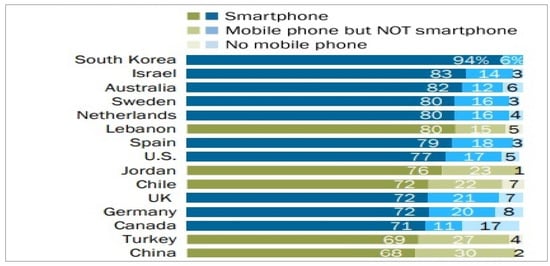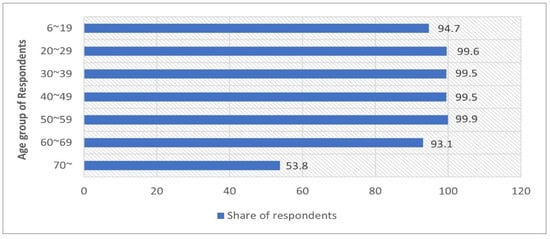You're using an outdated browser. Please upgrade to a modern browser for the best experience.
Please note this is a comparison between Version 1 by Kyeong-Ouk Jeong and Version 2 by Conner Chen.
With the growth of information and communication technology, technology-enhanced language learning has been increasingly regarded as a successful way to support learners with more interconnecting and collaborative language learning environments. Since smartphones have recently become an indispensable item in modern society, mobile-assisted language learning (m-learning) has been introduced to assist students’ language learning with the convenient features of digital devices and mobile technologies.
- mobile-assisted language learning
- self-directed learning
1. Introduction
The development of information and communication technology has been changing not only the lifestyle of modern people but also the educational environment at a striking speed. E-learning, which uses computers and the Internet to learn in class, has already become a common learning method, and the development of such information and communication devices provides both teachers and learners with opportunities to experience a new teaching and learning environment [1]. The global pandemic and spread of COVID-19 have accelerated the convergence of technology with the classroom in response to an emergency where the sustainability of education is at stake. With the recent innovative progress in digital technology, the use of digital devices today has penetrated into all aspects of our lives. Recently, mobile phones have become a must-have item for people living in the era of the digital revolution. Mobile phones are equipped with multitask functions such as wireless computer activity, phone function, camera function, memo function, and personal information management function without time and space restrictions. In addition, a lot of activities are possible with mobile phones, such as listening to music, watching video clips, using a navigator in driving, taking photos and videos, checking an e-calendar, taking notes, reading an e-book, and playing mobile games. Therefore, it can be said that mobile phones can be utilized as a new educational tool that can accelerate a new type of mobile learning environment [2]. Mobile devices are not only replacing traditional learning tools but are also being recognized as an expanded learning tool for the digital learning environment, which requires new teaching and learning functions [3]. Moreover, the characteristics of portable digital devices enable learner-centered education by enabling cooperative learning through ubiquitous interaction beyond face-to-face relationships in the classroom [4]. Integrating mobile phones in learning and teaching has received favorable responses from both educators and students [5]. Research results show that mobile devices could boost learner motivation, make the learning process more engaging, and help students acquire knowledge in an entertaining way [6].
In the field of English as foreign language education (EFL), there is no exception in efforts to integrate technology into the field of language learning and teaching [7]. With the development of the ICT industry, interest in mobile learning in the field of English teaching and learning is growing, and research is also being actively conducted [8][9][10][8,9,10]. As a result, the extensive use of technology-integrated instruction has made it possible for EFL learners to experience the diverse capabilities of technology in their language learning [11]. One of the most valuable affordances of mobile phones is situated learning [12]. In situated language learning environment, language learners can act as active constructors of their own knowledge as they learn to understand their own needs and develop learning styles and strategies. English communicative competence is best acquired within authentic contexts, in which students can be involved in realistic language learning tasks [13]. Technology-integrated instruction can help the students focus on the situated learning context in language learning and knowledge construction. Integrating language learning activities into real-world settings holds the potential to make learning more relevant and enjoyable [14]. With the more learner-centered innovative approaches of new technologies, language learners can have opportunities to achieve communicative competence while engaging in authentic communication in relevant and meaningful contexts [15]. Utilizing digital devices can support language learners in acquiring communicative competence to meet their learning needs and to engage them in authentic communication from meaningful and sustainable perspectives.
Incorporating digital devices, such as mobile phones or pads, into the language learning process has potential as an innovative language learning and teaching method due to several aspects, such as portability, agility, and connectivity [16]. As using mobile phones has become an integral part of everyday life for most college students, educators and researchers have been scrutinizing how to integrate digital smart devices into classroom procedures. The widespread use of smartphones among college students has prompted teachers to explore how this digital technology can help enhance learning motivation and maintain students’ sustainable learning experiences [17].
2. REnhance Learning Experience with Mobile-Assisted Language Learning
With the growth of information and communication technology, technology-enhanced language learning has been increasingly regarded as a successful way to support learners with more interconnecting and collaborative language learning environments. Since smartphones have recently become an indispensable item in modern society, mobile-assisted language learning (m-learning) has been introduced to assist students’ language learning with the convenient features of digital devices and mobile technologies [6][18][6,18]. In particular, in the situation in which schools have been shut down due to the global COVID-19 pandemic and the sustainability of education has been threatened, the role of m-learning becomes even more important to provide quality education to students outside of school and help them to continue their self-directed learning. Self-directed learning is the concept of autonomous learning outside the classroom dimension [19]. When schooling is threatened and too limited to allow meaningful learning to happen, as it is today, it is crucial to utilize the alternative educational resources available outside the classroom. The accessibility and flexibility of the mobile-assisted language learning environment provides students with more authentic learning opportunities, making it easier to adapt to unfamiliar learning experiences. This is why technology-enhanced m-learning is inevitable for sustainable self-directed learning [20]. M-learning can support students to develop digital literacy and technology competence. It also provides a learner-centered and self-directed learning environment where learning is autonomous and sustainable [21]. The ICT Development Index (IDI) is a composite index with 11 indicators combined into a composite score. It is used to monitor and compare developments in information and communication technology between countries over time. According to the International Telecommunication Union (ITU) report, South Korea placed 1st in the IDI (ICT Development Index) ranking among 147 countries in 2016 and 2nd out of 176 countries in 2017 [22]. Korea also shows higher levels of ICT accessibility, network infrastructure, ICT intensity of society, and ICT influence in digital literacy. Korea ranks first in the world for smartphone ownership and internet use. Nine out ten Korean adults make use of the internet and own a smartphone. Korea is also known as the country with the best internet connection in the world. It showed the highest internet penetration rate at 96 percent followed by the Netherlands and Australia (both at 93 percent) [23]. According to the report by the US-based Pew Research Center, South Korea recorded the highest smartphone ownership rate of 94 percent followed by Israel (83 percent) and Australia (82 percent) as seen in Figure 1 below [23].
Figure 1.
Global divide on smartphone ownership.

Figure 2.
Smartphone ownership South Korea 2020, by age group.
Table 1.
Features of mobile learning.
| Features | Contents |
|---|---|
| Mobility of learning spaces | Learning function through free movement without space restrictions Expanding learning places and experience opportunities |
| Flexibility and easy access to resources | Fast and flexible access to a variety of learning resources Timely learning is possible with instant access to the desired learning materials |
| Individualized learning topic | Customized learning tailored to the characteristics of the learners Personalized learning that meets the needs of learners |
| Simplicity of learning content | Systematic, structured, simplified, and modularized learning contents Provide learning focusing on concise and condensed core contents |
| Interactivity with learning objects | Changes in tools and methods of interaction Cooperative learning possible through immediate interactions |
| Contextuality of learning activities | Able to perform learning activities in real situations or contexts Integration of theoretical learning contents and practical experience |
